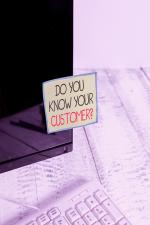CHICAGO — Standing out from the other companies on social media can be a headache for any small- to mid-sized business owner, dry cleaners included. Using every tool at your disposal is vital to getting through to your intended audience, and the use of hashtags can be one of the most valuable — and free — methods of breaking through.
This was the message of “Hashtags: Everything You Need to Know,” a webinar hosted by the Drycleaning & Laundry Institute (DLI) and presented by Rechelle Balanzat, CEO and founder of Juliette, a dry cleaner located in New York City. Prior to owning Juliette, Balanzat launched a social media agency in 2009, and was hired by companies to train them on how to leverage and integrate social media into their marketing and communication strategy.
In Part 1 of this series, we examined what hashtags are in social media, how they work and what they can accomplish. Today, we’ll continue by looking at how business owners can determine what makes them special, and what many consider to be the Holy Grail of social media — going viral.
#ViralPosts
To define the term “viral,” Balanzat used the definition from Oxford Languages: “Relating to or involving an image, video, piece of information, etc., that is circulated rapidly and widely from one internet user to another.”
“A viral campaign is when a hashtag starts to take on a life of its own,” she says, “and it starts to enter pop culture. It begins to reach people beyond your intended market. If you were trying to reach the Boston area or the Atlanta area, and then it goes beyond that, that’s when it becomes viral.”
Balanzat says that for professional in the drycleaning field, achieving this level of notoriety shouldn’t be their major goal.
“It’s really difficult to accomplish in our industry,” she says. “Not because there's anything wrong about our industry, but the whole point of becoming viral is that you were able to touch on a cultural phenomenon, or start a cultural phenomenon that resonates with people in a way that they just want to share something that excited them.”
Balanzat offered the example of a man on TikTok who talked about how he, for the first time in his life, discovered what dry cleaning is.
“It went viral because he got thousands of views,” she says. “That does touch on our industry, but we weren't the ones who created that content. It is very difficult to authentically create something viral without putting some intention behind it.”
Rather than one cleaner finding the magic hashtag that will allow him or her to go viral, Balanzat believes it would be much easier to break through to the culture with a combined effort.
“It can only happen if we all do it at the same time because virality comes from momentum,” she says. “If it's just one cleaner in New York trying to do it or one cleaner in Miami trying to do it, it's a disconnected effort, and it becomes difficult to become viral.”
The main goal of achieving virality, Balanzat says, isn’t just to get people talking, but to get people participating.
“It's one thing if your company creates a hashtag and you're constantly using it,” she says, “but it’s another when other people start using that hashtag. That's when you know it's catchy, and that people are engaging with it.”
And, in a field like dry cleaning, it’s more important that the local community becomes aware of a cleaner’s business for the long term, rather than achieving worldwide fame that burns out quickly. Balanzat believes that this is an area where hashtags can build that local momentum.
“With the right hashtags,” she says, “you make people feel connected to your brand, and you're saying something about who you are.”
#WhatMakesYouSpecial?
While they may offer many of the same services, drycleaning companies are distinctive because their owners are individuals. In social media marketing, finding what makes a company different is crucial for success.
“There's something unique about us that only we bring to the table,” Balanzat says. “Whatever that is, that's where you can start in brainstorming how to come up with a hashtag, how to communicate with people on social media and how to communicate with people through your digital marketing strategy.”
Balanzat used her own company and experience as an example.
“For me, personally, my niche is fashion,” she says. “So, a lot of our posts will use #fashion, #style, #OutfitOfTheDay or #PhotoOfTheDay. Our posts are playful. Every now and then we'll talk about just dry cleaning, but our customers are New Yorkers. They are playful, they're fashion forward. And we create the content that speaks to them. This is the niche audience that we have built over the years.”
Part of understanding how social media efforts are working is to stop to really look at the audience you’re building.
“I can tell by looking at our Instagram who our audience is,” Balanzat says. “It's very different from all the other laundry and drycleaning social profiles or Instagram profiles that are out there, because everyone has their own voice and their own brand. At Juliette, we spent a lot of time really honing in on who our audiences is, and we make sure that all of our content is relevant to them. And then we use the proper hashtags that speak to them.”
Come back Tuesday for the conclusion of this series, where we’ll explore how to use hashtags to connect with customers and how to track how well those hashtags are performing. For Part 1 of this series, click HERE.
Have a question or comment? E-mail our editor Dave Davis at [email protected].































































